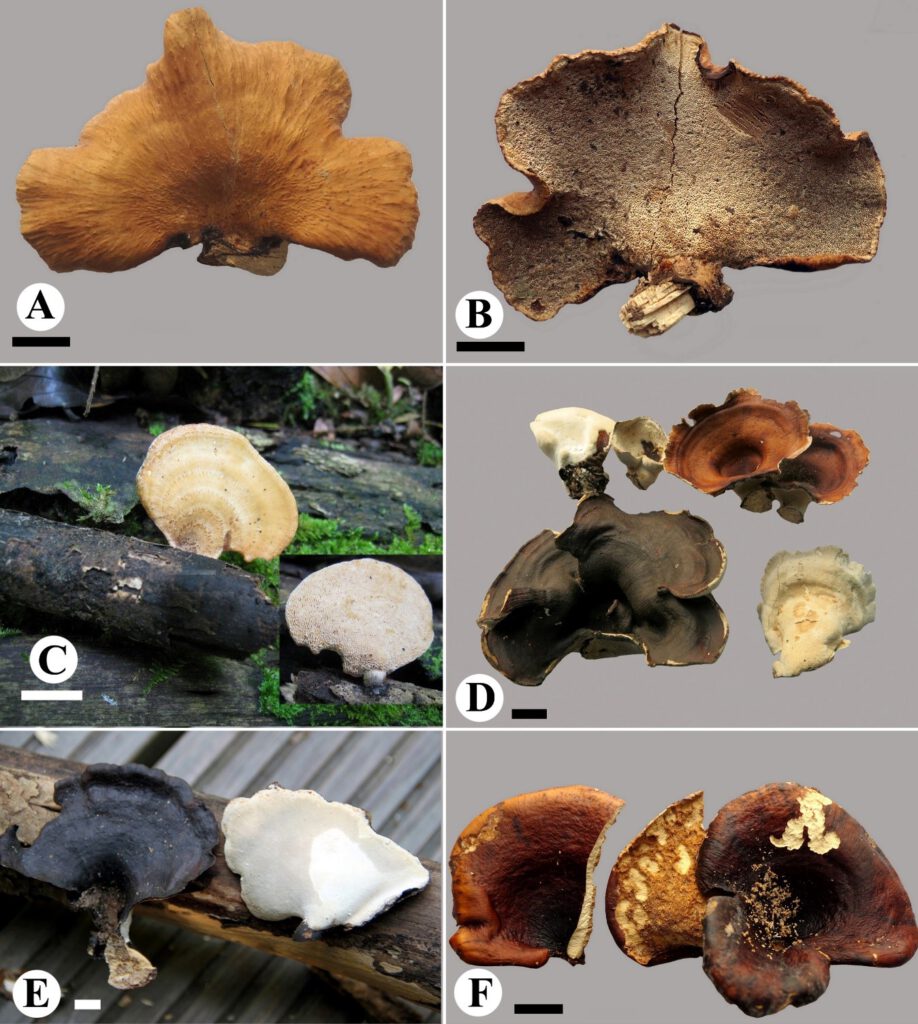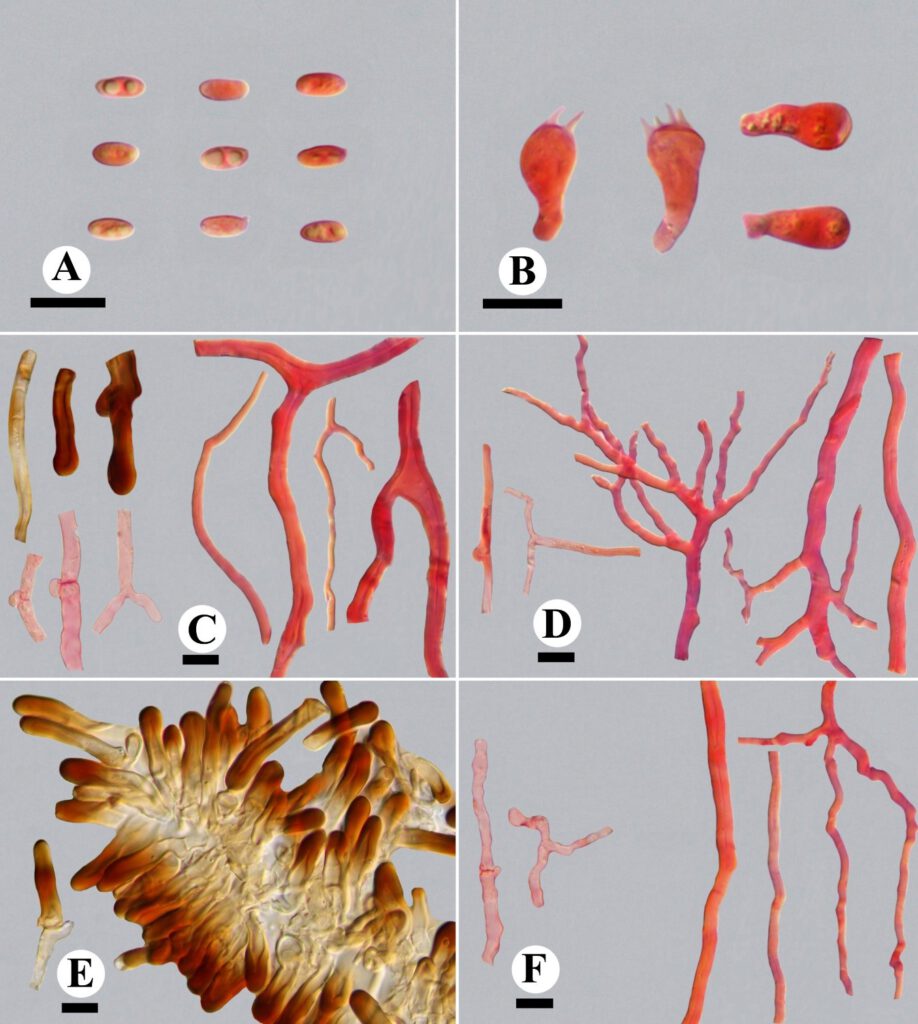Picipes auriculatus B.K. Cui, Xing Ji & J.L. Zhou, sp. nov.
MycoBank number: MB 559398; Index Fungorum number: IF 559398; Facesoffungi number: FoF 10646;
Description
Basidiomata – Annual, laterally stipitate, solitary, coriaceous when fresh, woody hard when dry. Pilei auricular to fan-shaped, about 1.7–5 cm long, 1–3 cm wide, and up to 4.5 mm thick at base. Pileal surface blackish red to black towards the stipe when fresh, becoming brownish red to yellowish brown towards the margin when dry, glabrous, with radially aligned stripes; margin incurved upon drying. Pore surface light ivory to honey buff when dry; pores circular to subcircular, 4–6 per mm; dissepiments thin, entire. Context light ivory to buff when dry, woody hard upon drying, up to 3 mm thick. Tubes concolorous with pore surface, up to 1.5 mm thick. Stipe very short or forming a flattened base, bearing a black cuticle, up to 3 mm long and 4.5 mm in diam.
Hyphal structure – Hyphal system dimitic; generative hyphae bearing clamp connections; skeleto-binding hyphae IKI–, CB+; tissues unchanged in KOH.
Context – Generative hyphae infrequent, colorless, thin-walled, occasionally branched, 1.8–6 μm in diam; skeleto-binding hyphae dominant, colorless, thick-walled with a wide to narrow lumen, frequently branched, interwoven, 1.3–8.2 μm in diam, rarely inflated at the branching area. Hyphae in cuticle towards the stipe with buff yellow to reddish brown inclusion inside, thick-walled with a wide lumen, bearing clamp connections, 2.2–7.5 μm in diam.
Tubes – Generative hyphae infrequent, colorless, thin-walled, occasionally branched, 1.3–5.9 μm in diam; skeleto-binding hyphae dominant, colorless, thick-walled with a wide to narrow lumen, with dendroid branches, strongly interwoven, 1.3–7.1 μm in diam. Cystidia and cystidioles absent. Basidia infrequent, clavate, with a basal clamp connection and four sterigmata, 13.3–17.6 × 5.5–7.5 μm; basidioles in shape similar to basidia, but slightly smaller.
Stipe – Generative hyphae infrequent, colorless, thin-walled, occasionally branched, 1.6–4.8 μm in diam; skeleto-binding hyphae dominant, colorless, thick-walled with a narrow lumen, frequently branched, interwoven, 1.6–6 μm in diam. Hyphae in cuticle with buff yellow to brown inclusion inside, thick-walled with a wide lumen, bearing clamp connections, 4–8.8 μm in diam.
Basidiospores – Basidiospores cylindrical, rarely oblong, colorless, thin-walled, smooth, frequently bearing two guttules, IKI–, CB–, (5.4–)5.8–6.8(–7) × (2.4–)2.5–3.2(−3.4) μm, L = 6.27 ± 0.35 μm, W = 2.82 ± 0.21 μm, Q = 1.8–2.69, Qm = 2.24 ± 0.18 (n=72/2).
Material examined: CHINA, on fallen angiosperm branch, 17 November 2015, B.K. Cui, Cui 13616 (BJFC, holotype); on fallen angiosperm branch, 12 November 2007, H.S. Yuan, Yuan 4221 (IFP, paratype).
Distribution: Tropical regions of China.
Sequence data: Cui 13616: ITS: KX900063.1 (ITS4/ITS5); LSU: KX900179.1 (LROR/LR7); nSSU: KX900289.1 (PNS1/NS41); mtSSU: KX900245.1 (MS1/MS2) Yuan 4221: ITS: KX900064.1 (ITS4/ITS5); LSU: KX900180.1 (LROR/LR7); nSSU: KX900290.1 (PNS1/NS41); mtSSU: KX900246.1 (MS1/MS2); EF1a: KX900366.1 (983/1567R)
Fig. 1–F Basidiomata of Picipes auriculatus (Cui 13616). Scale bars: 1 cm. Fig. 6 Microscopic structures of Picipes auriculatus. (A): Basidiospores; (B): Basidia and basidioles; (C): Hyphae from context; (D): Hyphae from trama; (E): Hyphae from cuticle of stipe; (F): Hyphae from stipe. Scale bars: A-F = 10 μm.

Fig. 1

Fig. 6
